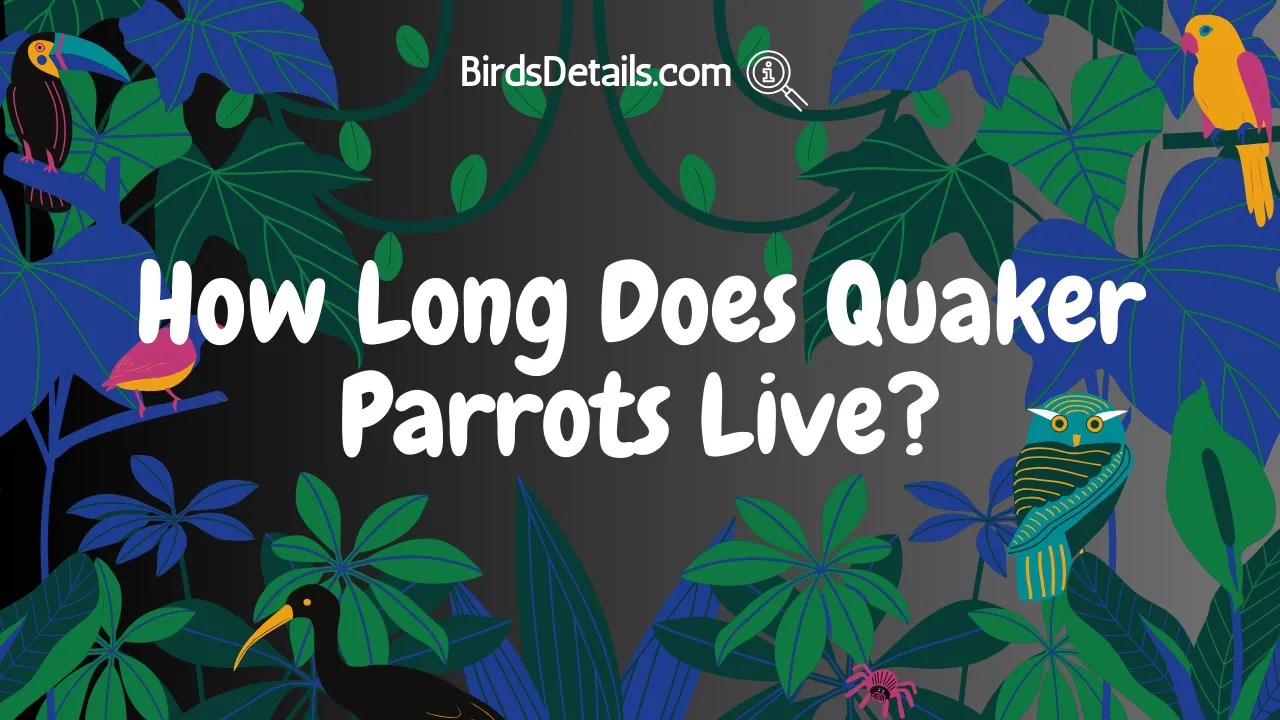How Long Does Quaker Parrots Live: Quaker parrots, also known as monk parakeets, or blue quakers, are popular captive birds due to their playful and social nature. One of the most common questions asked by potential owners is how long Myiopsitta Monachus lives. The lifespan of Quaker parrots can vary depending on various factors such as genetics, diet, exercise, and living conditions. To ensure the longevity of your pet, it is recommended to seek the advice of a vet and provide proper care to extend their lifespan.
The average lifespan of captive quaker parrots, including blue quakers and monk parakeets, is around 20 to 30 years. These birds can live a long time with proper care, with some Quaker parrots known to live up to 35 years or more. However, in the wild, the lifespan of Quaker parrots is shorter due to predation, disease, and other environmental factors.
As pets, monk parakeets, also known as blue quakers, require good care and general care that includes regular visits to the veterinarian for check-ups and vaccinations. A balanced diet that includes fresh fruits and vegetables along with high-quality pellets is essential for their health. Exercise is also crucial for their physical and mental well-being.
Providing good care and a safe living environment is equally important for extending the lifespan of quaker parrots, including blue quakers and monk parakeets. Their cage should be spacious enough for them to move around comfortably with plenty of toys for stimulation. It’s also essential to keep their cages clean and free from harmful substances such as chemicals or toxic fumes, especially since they are popular in the pet trade.
In addition to proper care at home, early detection and treatment of any health issues can help prolong the life of a pet quaker parrot or monk parakeet. Regular veterinary check-ups can ensure any problems are caught early before they become serious, giving monk parrots ample time to recover.
Factors that can Increase the Lifespan of Quaker Parrots
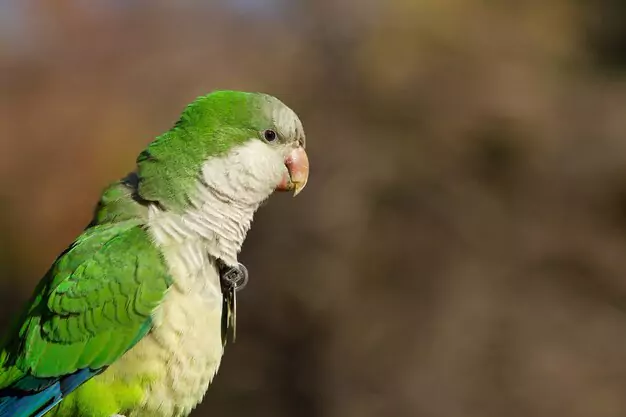
Healthy Diet for Quaker Parrots
Providing a healthy and balanced diet is crucial to increasing the lifespan of Quaker parrots, also known as monk parakeets, in the pet trade. These birds require a variety of fresh fruits, vegetables, and high-quality pellets for their general care to maintain optimal health. A diet that lacks essential nutrients can lead to various health issues such as feather plucking, obesity, and malnutrition.
To ensure that your Quaker parrot, also known as a monk parakeet, receives all the necessary nutrients for their species, offer them a mix of fresh fruits and vegetables such as apples, carrots, broccoli, spinach, and sweet potatoes. Provide them with high-quality pellets that are specially formulated for their dietary needs. Avoid feeding them foods that are high in fat or sugar as it may harm their health. This is especially important for pet owners who have acquired these birds through the pet trade.
Regular Exercise and Playtime
Quaker parrots, also known as monk parakeets, are a species of active birds that require regular exercise to maintain their physical and mental health for a long life. Providing them with toys and playtime outside their cage can help keep these Quakers stimulated and prevent boredom. Regular exercise is also essential in preventing obesity, which can lead to various health problems in this species such as heart disease.
Make sure your parrot species, including monk parakeets and quaker parakeets, have enough space in their cage to move around comfortably. Offer them different types of toys such as ropes, swings, bells, or puzzles to keep them entertained. Make sure to include a parrot nest in the cage for them to sleep in. Also, take your birds out of their cage regularly for supervised playtime outside where they can explore new surroundings.
Clean Living Environment
A clean living environment is essential for maintaining the health of your Quaker parrot and monk parakeets. Ensure that their cages are cleaned regularly by removing any uneaten food or droppings promptly. Disinfect the cages once a week with bird-safe cleaning products to ensure the health of both species. Make sure to allocate enough time for cleaning and maintenance to keep both your Quakers and monk parakeets healthy and happy.
Make sure there are no potential hazards inside or near the bird’s cage such as toxic substances or sharp objects that could harm it if ingested or touched accidentally, especially for parrot species such as monk parakeets, quaker parakeets, and those that build parrot nests.
Regular Veterinary Check-Ups
Just like humans require regular check-ups with their doctors; monk parakeets, also known as Quaker parrots, of the blue species need regular visits to an avian veterinarian for preventative care check-ups too. Regular check-ups will help catch any health issues early on, increasing the chances of successful treatment and a longer lifespan.
During these check-ups, the veterinarian will perform a physical exam on your bird species, including monk parakeets and quaker parakeets such as the blue quaker. They will take blood samples for testing and check for any signs of illness or disease, offering advice on how to improve their diet and living environment.
Socialization with Humans and Other Birds
Quaker parrots, also known as monk parakeets, are social birds that thrive on interaction with their owners and other birds. Socialization helps reduce stress levels in parakeets which can lead to various health problems such as feather plucking or aggression.
Spend time with your bird daily by talking to it, playing games, or offering treats. Consider getting another Quaker parrot or monk parakeet as a companion for your bird if you don’t have one already. However, ensure that they both get along well before leaving them unsupervised together.
Choosing the Right Cage for Your Quaker Parrot
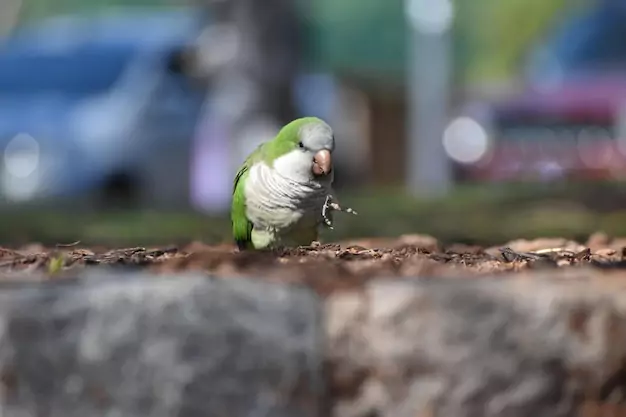
Cage size matters: Choose a cage that is at least 18 x 18 x 18 inches in size for monk parakeets, quaker parakeets, and blue quakers.
One of the most important things to consider when choosing a cage for your Quaker parrot, monk, or parakeet is the size. Your pet bird will need enough space to move around, stretch its wings, and play. A good rule of thumb is to choose a cage that is at least 18 x 18 x 18 inches in size. This will provide enough room for your Quaker parrot, monk, or parakeet to spread their wings and move around comfortably.
However, keep in mind that this is just the minimum recommended size for Quaker parrots. If you have parakeets or a monk parrot, they may require different cage sizes. If possible, provide a larger cage as the more space your bird has, the happier and healthier it will be.
Sturdy materials are key: Look for a cage made of stainless steel or wrought iron suitable for quaker parakeets, monks, and blue quakers.
When shopping for a Quaker parrot cage, it’s important to look for one made of sturdy materials such as stainless steel or wrought iron. These materials are durable and long-lasting, so you won’t have to worry about replacing the cage anytime soon. Whether you’re looking for a cage for your parakeet or monk parrot, these materials will provide the necessary strength and security.
They are easy to clean and maintain. Stainless steel cages are particularly popular among bird owners because they are rust-resistant and non-toxic. This means that even if your Quaker parrot, parakeet, or monk chews on the bars of its cage (which they often do!), there’s no risk of ingesting harmful chemicals or substances.
Horizontal bars are essential for quaker parakeets like the blue quaker and monk to climb and play in their cages.
Quaker parrots and monk parakeets love to climb and play, so it’s important to choose a cage with horizontal bars that allow them to do so. Vertical bars may look nice, but they don’t provide as much opportunity for exercise and play as horizontal ones do.
In addition to providing horizontal bars inside the cage, consider adding toys and perches that encourage climbing and exploration. Providing different textures and materials can also keep your Quaker parrot entertained and mentally stimulated. If you have a monk parrot, make sure to provide enough space for them to move around freely.
Perches are a must: Provide at least one perch inside the cage for your Quaker parrot or monk parakeet to rest on.
Finally, make sure to provide at least one perch inside the cage for your Quaker parrot or monk parakeet to rest on. Perches should be made of natural materials such as wood or rope, as these are comfortable for birds to grip and stand on.
It’s important to choose perches of different sizes and shapes, so your Quaker parrot can exercise its feet and prevent foot problems. Placing perches at different heights within the cage can encourage movement and exercise. Adding a monk to the cage can also provide a companion for your parrot.
Providing a Healthy and Diverse Diet for Quaker Parrots
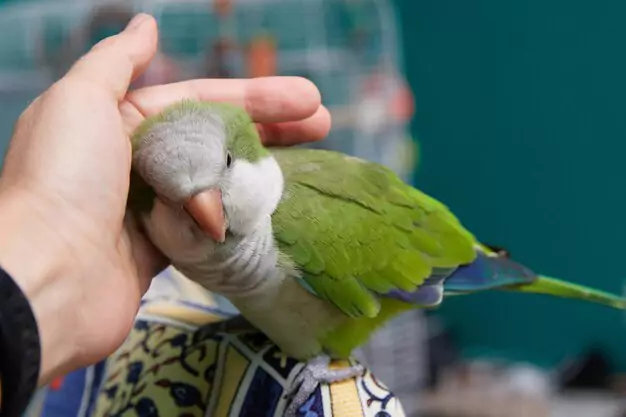
A healthy and diverse diet is crucial for the longevity of Quaker parrots. These birds require a balanced diet that consists of fresh fruits, vegetables, grains, and protein. In addition, if you have a monk parrot, you should know that they have similar dietary needs to Quaker parrots. Therefore, providing a healthy and varied diet is also essential for the health and well-being of your monk parrot.
A Balanced Diet for Quaker Parrots
Quaker parrots and monk parakeets require a balanced diet that includes fresh fruits, vegetables, grains, and protein. A variety of foods should be offered to ensure that they receive all the necessary nutrients. Fruits such as apples, bananas, berries, and oranges are excellent sources of vitamins and minerals for both Quaker parrots and monk parakeets. Vegetables such as broccoli, carrots, kale, and spinach are rich in fiber and antioxidants which is also good for both birds. Grains like brown rice or whole wheat bread provide carbohydrates while seeds offer protein for Quaker parrots and monk parakeets.
Avoid Processed or Sugary Foods
Processed or sugary foods can cause health problems in Quaker parrots. Avoid feeding them with junk food like chips or candy bars as these contain high levels of salt and sugar which can lead to obesity and other health issues. Also, avoid giving them chocolate which is toxic to birds. Additionally, it is important to note that feeding Quaker parrots a diet that includes monk fruit can be beneficial for their health.
Provide Fresh Water Daily
Fresh water is essential for keeping your Quaker parrot and monk hydrated and healthy. Change their water daily to prevent bacteria growth in their drinking bowl.
Consult with a Veterinarian or Avian Specialist
Consulting with an avian veterinarian or specialist can help you determine the best diet plan for your Quaker parrot or monk parakeet based on its age, weight, activity level, and health conditions among other factors unique to each bird. This way you can ensure that they get all the necessary nutrients to maintain good health.
Nesting and Breeding of Quaker Parrots

Quaker parrots, also known as monk parakeets, are fascinating and social birds that can make excellent pets. In this section, we will discuss the nesting and breeding habits of Quaker parrots.
Communal Nests
Quaker parrots are unique in that they often build communal nests with other members of their species. These nests can be quite large and elaborate, made of sticks and twigs intertwined to create a sturdy structure. In the wild, Quaker parrots build these nests in trees or on power lines. However, some monk parakeets have also been observed building similar communal nests.
Captive Quaker Parrots
Captive quaker parrots can also build nests in their cages or aviaries but may require nesting materials such as shredded paper or coconut fiber. Providing them with these materials can encourage nesting behavior and help keep them occupied. It is important to note that not all captive Quaker parrots will exhibit nesting behavior, as it is dependent on various factors such as age and gender.
Breeding Challenges
Breeding quaker parrots can be challenging for pet owners due to potential aggression towards potential mates or offspring. It is essential to ensure that both birds have been properly socialized before attempting to breed them. Feather plucking is a common issue among captive Quaker parrots which can cause stress and affect their ability to breed successfully.
Predators
In the wild, predators such as hawks and snakes pose a significant threat to Quaker parrot populations. This makes it even more important for pet owners to provide a safe environment for their birds by ensuring that cages are secure and free from any potential dangers.
Costs
The cost of blue quakers varies depending on location and availability. On average, they range from $400-USD 800 each.
Training and Behavioral Guidance for Your Quaker Parrot
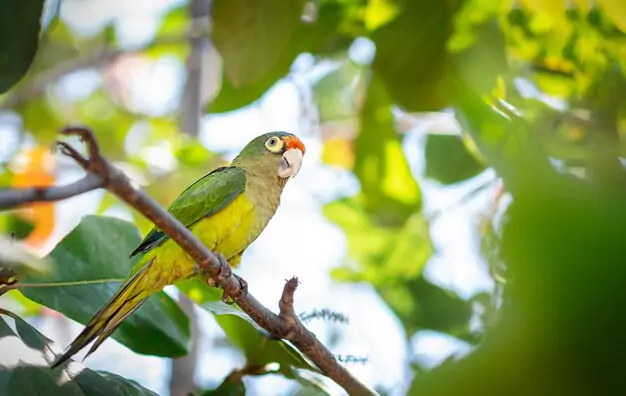
Training your Quaker parrot is essential to ensure a happy and healthy pet. Parrots from pet stores or the pet trade can learn words and mimic sounds, making them an entertaining addition to any family. However, without proper training and guidance, these intelligent birds can develop problem behaviors that may be difficult to correct later on.
Following a consistent training form can help prevent problem behaviors in your Quaker parrot. Positive reinforcement is one of the most effective methods for training birds. This involves rewarding good behavior with treats or praise while ignoring bad behavior. Consistency is key when using this method as it reinforces the idea that good behavior will always be rewarded.
Part of the training includes teaching your Quaker parrot to use its bill and structures appropriately. This can include teaching them not to bite or chew on furniture or other household items. Providing appropriate toys and structures for your bird to play with can also help prevent destructive behavior.
Providing a loving and attentive family environment is crucial for the overall well-being of your Quaker parrot. These social creatures thrive on interaction with their human family members, so regular attention and playtime are important aspects of their care. Neglecting these needs can lead to behavioral issues such as feather plucking or aggression.
Understanding the Lifespan of Quaker Parrots in the Wild vs Captivity
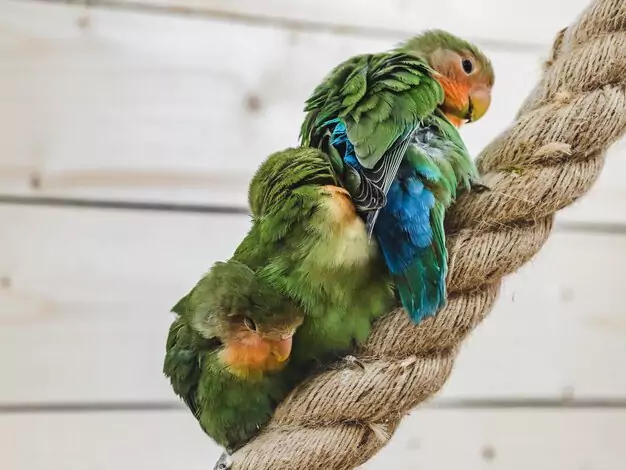
Lifespan of Quaker Parrots in the Wild vs Captivity
Wild Quaker parrots can live up to 20 years, while captive Quaker parrots have an extended lifespan of up to 30 years. The difference in their lifespan is due to several factors, such as environmental conditions and healthcare.
In the wild, Quaker parrots face various threats that can shorten their lifespan. Predators like hawks and snakes pose a significant threat to these birds. Diseases and harsh weather conditions can also contribute to their shorter lifespan. Wild Quaker parrots must fend for themselves and find food and shelter on their own.
On the other hand, captive Quaker parrots are provided with a controlled environment that reduces the risks of predation and exposure to diseases. They receive regular veterinary care and proper nutrition that contributes significantly to their longer lifespan. Moreover, they are not subject to harsh weather conditions that could negatively impact their health.
Proper nutrition is essential for extending the life of captive Quaker parrots. A balanced diet consisting of fruits, vegetables, seeds, and pellets should be provided daily. Regular veterinary check-ups are also necessary for detecting any underlying health issues early on before they become severe.
A stress-free environment is crucial for maintaining the physical and mental health of captive Quaker parrots. Adequate space should be provided for them to fly around freely without feeling cramped or confined. Social interaction with humans or other birds is also vital in keeping them mentally stimulated.
While captivity does offer several advantages over living in the wild it’s important not to neglect their social needs entirely. Quaker parrots are highly social creatures that thrive on interaction with others of their kind or humans who take care of them.
Comparing the Lifespan of Wild and Pet Quaker Parrots
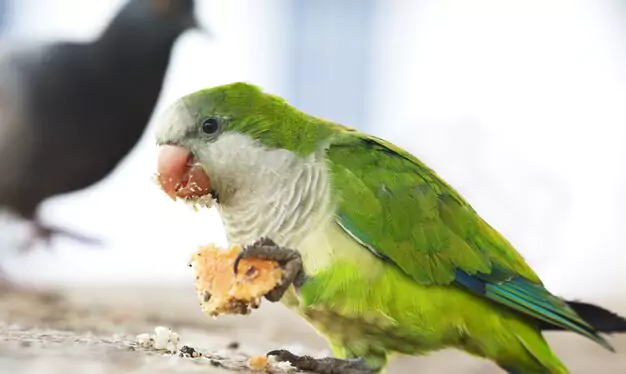
Wild Quaker parrots are known for their longevity, with an average lifespan of around 20 years. However, pet Quaker parrots typically live for about 15 years. This difference in lifespan can be attributed to a variety of factors, including the care and attention provided by owners, as well as the various threats faced by wild populations.
One way to help extend the life of pet Quaker parrots is through regular check-ups with a veterinarian. Vets can guide proper nutrition and exercise, as well as identify any potential health issues before they become serious problems. Providing a stress-free environment for pet quaker parrots can help reduce the risk of illness or injury.
In contrast, wild Quaker parrots face numerous challenges that can shorten their lives. Predators such as hawks and snakes pose a constant threat to these birds, while disease outbreaks and habitat loss can also have significant impacts on population size and longevity.
Despite these challenges, there are still steps that can be taken to help protect wild Quaker parrot populations. For example, conservation efforts aimed at protecting nesting sites and reducing exposure to pesticides have been shown to have positive effects on population growth and reproductive success.
Ultimately, whether you are caring for a pet Quaker parrot or working to protect wild populations, understanding the factors that influence these birds’ lifespans is crucial. By providing proper care and taking steps to mitigate threats in both captive and natural settings, we can help ensure that these beloved birds continue to thrive for many years to come.
Native Range and Distribution of Quaker Parrots

South American Origins: Quaker Parrots
Quaker parrots are known for their bright green feathers and charming personalities, but where do these birds come from? Quaker parrots are native to South America, specifically the subtropical regions of Argentina, Bolivia, Brazil, and Uruguay. These areas provide an ideal habitat for Quaker parrots due to their warm climate and abundance of food sources.
Introduced to North America: Quaker Parrots as Pets
In the 1960s, Quaker parrots were introduced to North America as pets. These intelligent birds quickly became a popular choice among pet owners due to their playful nature and ability to mimic human speech. However, some pet owners found it difficult to care for these birds properly due to their high energy levels and need for socialization.
Feral Populations in the United States
Despite being introduced as pets, Quaker parrots have established feral populations in several states across the United States. They are considered an invasive species in some areas due to their impact on local ecosystems. Feral quaker parrot populations can be found in Florida, Texas, California, New York City, and other parts of the country.
Monastic Nesting Habits
Quaker parrots are also known as monk parakeets due to their unique nesting habits. Unlike most bird species that build individual nests for each pair or family group, quaker parrots build communal nests that can house dozens of individuals at once. These nests often resemble small apartment complexes with separate chambers for each family unit.
Natural Habitat
In addition to their fascinating nesting habits and lively personalities, Quaker parrots are well-adapted to life in grasslands, savannas, and forests throughout South America. They thrive on a diet of seeds and fruits from native trees such as acacia and eucalyptus.
Caring for Your Quaker Parrot to Promote a Long and Happy Life
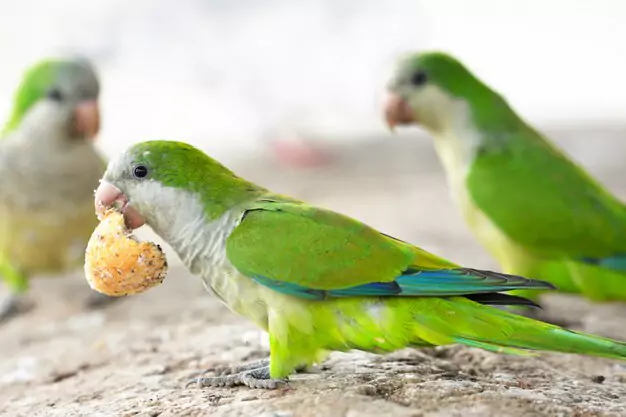
Proper Care is Crucial to Promoting a Long and Healthy Life for Your Quaker Parrot
Quaker parrots are intelligent, social birds that can make wonderful pets. To ensure that your bird lives a long and happy life, it’s important to provide proper care. Here are some tips on how to care for your Quaker parrot.
Good Care Includes Providing a Balanced and Nutritious Diet
A balanced and nutritious diet is essential for the health of your Quaker parrot. A good diet should include fresh fruits, vegetables, grains, and protein sources such as cooked chicken or eggs. Avoid feeding your bird foods that are high in fat or sugar, such as junk food or candy.
In addition to providing a healthy diet, make sure your quaker parakeets, including blue quaker, have access to clean water at all times. Change the water daily and clean the water dish regularly.
Regular Exercise is Key
Quaker parrots are active birds that need plenty of exercise to stay healthy. Provide toys and perches in their cage so they can climb, swing, and play. You can also let them out of their cage for supervised playtime outside of their enclosure.
Make sure your Quaker parakeet or blue quaker has enough space in their cage to move around freely without feeling cramped. A larger cage will also allow you to provide more toys and perches for them to play with.
A Clean Living Environment is Essential
Keeping your quaker parakeet’s living environment clean is crucial for their health. Regularly clean their cage by removing any uneaten food or droppings from the bottom of the cage. Wipe down perches and toys with a damp cloth as needed.
It’s also important to keep the air in their environment clean by avoiding smoking or using harsh chemicals near them.
Routine Check-ups with an Avian Veterinarian are Important
Regular check-ups with an avian veterinarian can help identify any potential health problems early on. Make sure you find a veterinarian who is experienced in treating birds.
During check-ups, the veterinarian will examine your bird’s overall health, including their feathers, eyes, and beak. They may also recommend additional tests or treatments if necessary.
Fatty Liver Disease is a Common Health Issue in Quaker Parrots
Fatty liver disease is a common health issue in Quaker parrots that can be prevented with proper diet and exercise. This condition occurs when fat accumulates in the liver, which can lead to liver failure if left untreated.
To prevent fatty liver disease, make sure your bird has a healthy diet that is low in fat. Encourage regular exercise by providing toys and perches for them to play with.
Conclusion: Understanding the Lifespan of Quaker Parrots
Understanding the Lifespan of Quaker Parrots
Quaker parrots, also known as monk parakeets, are intelligent and social birds that make great pets. However, before bringing one home, it’s important to understand their lifespan and how to care for them properly to ensure they live a long and healthy life.
Factors such as genetics, diet, environment, and veterinary care can all play a role in determining the lifespan of a Quaker parrot. While there is no definitive answer on how long these birds can live, most experts agree that with proper care and attention, they can live up to 20-30 years or even longer in captivity.
Choosing the right cage for your Quaker parrot is crucial for its health and well-being. The cage should be large enough for your bird to move around comfortably with plenty of room for toys and perches. It should also be placed in an area that’s free from drafts and direct sunlight.
A diverse and healthy diet is essential for maintaining your Quaker parrot’s health. In addition to seed mixes, they should also be given fresh fruits and vegetables daily along with occasional treats such as nuts or cooked eggs.
Breeding quaker parrots requires careful consideration as it can be stressful on both the male and female birds. If you do decide to breed your Quakers, provide them with a suitable nesting box that’s large enough for both birds along with plenty of privacy.
Training your Quaker parrot is important not only for its mental stimulation but also for building trust between you and your bird. Positive reinforcement techniques such as clicker training can help teach your bird new tricks while also strengthening your bond.
While captive-bred Quaker parrots tend to have longer lifespans than those in the wild due to better nutrition and medical care, it’s important to remember that these birds are still wild animals at heart. Providing them with plenty of opportunities for exercise and mental stimulation can help keep them happy and healthy.
